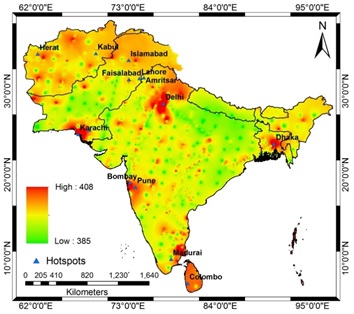Evaluation of Catastrophic Global Warming due to Coal Combustion, Paradigm of South Asia
DOI:
https://doi.org/10.33411/ijist/2021030406Keywords:
Black Carbon, Carbon Dioxide, Global Warming, Coal ConsumptionAbstract
Coal is a carbon containing non-renewable fossil fuel and one of the major contributors of climate change and global warming. We used TANSO FTS instrument in order to obtain the level of atmospheric carbon dioxide through datasets obtained from GOSAT satellite. GIOVANNI was also used to obtain atmospheric concentration of various gases. Burning of coal causes emission of greenhouse gases (GHG) and black carbon (BC) in atmosphere which are responsible for nearly 0.3°C of 1°C rise in temperature. The annual average value of carbon emission for the year 2010 and 2019 is 388.4 ppm and 409 ppm respectively. Since the pre-industrial times CO2 concentrations have increased up to100 PPM (36%) in the last two and a half centuries (250 years).In South Asia Dhaka has the worst quality of air as CO2 concentration (6.7%) is higher than the country’s GDP (5.25%) and energy consumption (4.77%). While an increasing trend GHG has been observed in Lahore up to 5.5 %. This study concludes that the high concentration of carbon dioxide in atmosphere is responsible for average rise of 1.2 °C temperature annually. This temperature rise can lead to adverse climatic conditions i.e., melting of glaciers which will consequently rise the sea level various landmasses may disappear by 2050.
References
Braslau, Norman, and J. V. Dave. "Effect of aerosols on the transfer of solar energy through realistic model atmospheres. Part I: Non-absorbing aerosols." Journal of Applied Meteorology and Climatology 12.4 (1973): 601-615.
Nayak, Harsita, Shiv Poojan Yadav, and Deepak Kumar Yadav. "Contribution of Natural and Anthropogenic Activities in Greenhouse Gases Emission." Energy 4: 2.
Al‐Ghussain, Loiy. "Global warming: review on driving forces and mitigation." Environmental Progress & Sustainable Energy 38.1 (2019): 13-21.
Allen, L. H., Jr. 1990. Plant responses to rising carbon dioxide and potential interactions with air pollutants. J. Environ. Qual. 19:15-34.
Singh, Bharat Raj, and Onkar Singh. "Study of impacts of global warming on climate change: rise in sea level and disaster frequency." Global warming—impacts and future perspective (2012).
Flannery, Tim. The weather makers: The history and future impact of climate change. Text Publishing,2008. Alastuey, A., X. Querol, S. Rodriguez, F. Plana, A. Lopez-Soler, C. Ruiz, and E. Mantilla. "Monitoring of atmospheric particulate matter around sources of secondary inorganic aerosol." Atmospheric Environment 38, no. 30 (2004): 4979-4992.
Abghari,H.,Tabari,,&Talaee, P.H.(2013).River flow trends in the west of Iran during the past 40 years: impact of precipitation variability. Global and Planetary Change, 101, 52–60.
Alexander,V.,Zhang,X.,Peterson,T.C.,Caesar,J.,Gleason, B.,Tank,A.M.G.K.,etal.(2006).Global observed changes in daily climate extremes of temperature and precipitation. Journal of Geophysical Research, 111,D05109. Ambenje,,e tal.(2007).InS.Solomon,D.Qin,M.Manning,Z. Chen,M.Marquis,K.B.Averyt, M.Tignor,&H.L.Miller (Eds.), IPCC, 2007: climate change 2007: the scientific basis. Contribution of working group It othe fourth assessment report of the inter-governmental panel on climate change(p.243).Cambridge: Cambridge University Press.
Wester hold etal., "An astronomically dated record of Earth’s climate and its predictability over the last 66 million years," Science vol. 369 (11 Sept. 2020), 1383-1387.
Ratafia-Brown, Jay A. "Overview of trace element partitioning in flames and furnaces of utility coal-fired boilers." Fuel Processing Technology 39.1-3 (1994): 139-157.
Dove, Jane. "Student teacher understanding of the greenhouse effect, ozone layer depletion and acid rain." Environmental education research 2.1 (1996): 89-100.
https://www.worldometers.info/coal/pakistan-coal/
Raghuvanshi, Shiv Pratap, Avinash Chandra, and Ashok Kumar Raghav. "Carbon dioxide emissions from coal based power generation in India." Energy Conversion and Management 47.4 (2006): 427-441.
https://www.nrdc.org/stories/fossil-fuels-dirty-facts
Noor.T, Nazeer.I, Attique. Z, Shahzad. M “Global temperature variations since pre industrial era”. International Journal of Innovations in Science & Technology, Vol 03 Issue 02: pp 67-74, 2021.
CC, 2013b: Summary for Policymakers. In: Climate Change 2013: The Physical Science Basis. Contribution of Working Group I to the Fifth Assessment Report of the Intergovernmental Panel on Climate Change
[Stocker, T.F., D. Qin, G.K. Plattner, M. Tignor, S.K. Allen, J. Boschung, A. Nauels, Y. Xia, V. Bex, and P.M. Midgley (eds.)]. Cambridge University Press, Cambridge, United Kingdom and New York, NY, USA, pp. 3–29.
IPCC, 2012a: Summary for Policymakers. In: Managing the Risks of Extreme Events and Disasters to Advance Climate Change Adaptation [Field, C.B., V.R. Barros, T.F. Stocker, D. Qin, D.J. Dokken, K.L. Ebi, M.D. Mastrandrea, K.J. Mach, G.-K. Plattner, S.K. Allen, M. Tignor, and P.M. Midgley (eds.)]. Cambridge University Press, Cambridge, United Kingdom and New York, NY, USA, pp. 3–21.
International Energy Agency, Energy Technology Perspectives 2020, Special Report on Carbon Capture Utilisation and Storage – CCUS in clean energy transitions (September 2020)
Haq.U.E, Waseem.F“ Appraisal of Temporal Variations in Atmospheric Compositions over South Asia by Addition of Various Pollutant’s in Recent Decade”. International Journal of Agriculture & Sustainable Development, Vol 03 Issue 01: pp 01-15, 2021.
https://www.climate.gov/maps-data/dataset/greenhouse-gas-concentrations-graphing-tool

Published
How to Cite
Issue
Section
License
Copyright (c) 2021 50Sea

This work is licensed under a Creative Commons Attribution 4.0 International License.




















